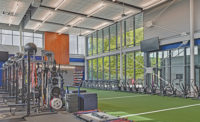The Top Specialty Contractors surveys from the New England and New York regions show that firms continued to grow in 2019, with total revenue up slightly from 2018, providing a much needed cushion to cope with COVID-19 impacts faced this year.
Two of the New York region’s three top-ranked firms held their places on the 2020 list, while list leaders shifted places in New England, which includes Connecticut, Maine, Massachusetts, New Hampshire, Rhode Island and Vermont.
The top 25 firms in New York and New Jersey reported combined revenue of $2.56 billion, up just 0.3% from $2.55 billion the year before. E-J Electric Installation Co. remained at No. 1 among specialty firms in the New York region, reporting $637.1 million in 2019 revenue. Staying in second place on the ranking is Five Star Electric Corp., which reported $357 million. Electra USA Inc., which did not participate in last year’s survey, reported revenue of $222 million to land in third place on the 2020 ranking.
On this year’s New England ranking, the leading 17 firms, out of 23 ranked, reported $1.9 billion in combined 2019 revenue, up 19% compared with the top 17 participating firms in last year’s survey.
S&F Concrete Contractors Corp., with $264.48 million in 2019 revenue, catapulted to the top slot this year from fourth place last year. The top-ranked firm in 2019, Wayne J. Griffin Electric Inc., is second on this year’s list with $242.10 million. E.M. Duggan Inc. rounds out the top three with $233.50 million; the mechanical contractor ranked second the year before.
Executives from firms that ranked on one or both regional lists—Insulation Asbestos Remediation (IAR), Sessler Environmental Services and Universal Builders Supply (UBS) in the New York region and United Civil and W.L. French Excavating Corp. in New England—shared their market insights. Their responses have been edited for space and clarity.
|
Related Links |
What sectors have offered your firm the greatest opportunity in your region?
Tom Dion, Vice President, W.L. French Excavating Corp.: We noticed an uptick in opportunities in the biopharmaceutical and e-commerce distribution markets.
Michael Dell Isola, Vice President, United Civil: Our primary work sector, underground energy infrastructure, has remained steady because these projects are deemed critical.
Chris Evans, President, UBS: Regionally, we have seen the most activity in the commercial and residential sectors.
Karen Grando, CEO, IAR: Even throughout the panademic, opportunities remain in projects associated with infrastructure, specifically transportation, pharmaceuticals and residential construction. While the majority of public work came to a halt during the COVID-19 shutdown, projects that were federally funded seemed to continue to progress.
Charles Morgan, CEO, Sessler Environmental Services: Abatement work remains strong, demolition is competitive and remediation has seen a longer trend of going to bid.
Which sectors have cooled down for your firm?
Dion: Commercial office and mixed-use development work has slowed down.
Dell Isola: Schools are hit hardest. Capital projects like utility infrastructure for higher education clients have been postponed or canceled altogether with the exception of emergency repairs.
Evans: Over the past several years, there had been a significant amount of development in the high-rise market, both commercial and residential. While we have yet to see the full effects of the pandemic, there appears to be a slowdown in both of these markets.
Grando: What seems to have cooled down most significantly is new non-residential tenant work. Companies now are considering alternative ways of conducting business—offsite employees, virtual meetings, etc. The uncertainty of what an office environment will look like in the future has brought this type of construction to a virtual halt.
Morgan: Remediation work had been slower in going to bid phase from approved design phase.
What are major construction trends in the New York/New Jersey and New England regions?
Evans: Institutional work, such as hospitals, appears to be staying strong, and there may be an increase in public and government work.
Dell Isola: Virtual meetings have become more efficient for managers and client interactions.
Grando: Over the past several years, we have noticed a lot of projects in our region trend toward being non-union with increased goals, or set-asides, for women- and minority-owned businesses and a major increase in safety and certification requirements for all jobsites.
Morgan: Former industrial facilities that are seeing real estate redevelopment have provided our company significant advantages as we offer abatement, demolition and remediation with our own skilled staff.
What key innovations helped your firm boost productivity or other metrics?
Dion: One key to increased productivity has been development of our own custom software. For the past three years, our employees have helped design and build our own programs that connect all areas of the company. It has allowed continued growth and efficiencies suited to our needs and those of our clients.
Evans: Mobile software for tracking employee time and productivity in real time has helped us increase efficiency and streamline internal processes.
Grando: Our firm has greatly benefited from adoption of smart devices in the field. Project managers no longer need to call the main office for information or details pertaining to a specific project. All information is accessible at any time.









